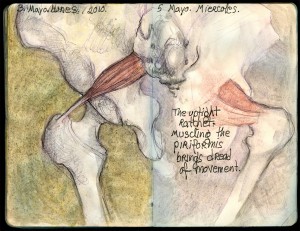The piriformis muscle and the SI joint (sacroiliac joint) have a special relationship.
I have been putting up Sharon Frost’s beautiful drawings on our Pinterest page and the images above seemed perfect for the topic of my last few posts so I figured I would expand upon it a bit.
The piriformis muscle is one of only two muscles that connect the legs to the spine (the psoas major is the other) and the SI joint is where the spine meets the pelvis. Together they are a bridge between the upper and lower body.
The piriformis muscle is such a mess in so many people because almost everyone has a misaligned pelvis.
It is a muscle that suffers by design if we have poor posture and in turn, the SI joint must suffer as well.
The piriformis spans from the outer leg to the front portion of the pelvis crossing the SI joint on the way. It externally rotates the leg when the leg is straight and pulls the leg out to the side when the knee is bent.
The action of moving your leg to get out of a car is a perfect illustration of the use of the piriformis.
The SI joint is meant to be slightly mobile and successful walking patterns depend on the ability of the hips to roll independently as we ambulate.
This requires movement in the SI joint and though this movement is barely perceptible the fluidity of the SI joint is of paramount importance for the health of the spine and body. Move it or lose it.
A tight piriformis by nature inhibits the SI joint. The pull of a tight piriformis muscle will lessen or eliminate the space in the SI joint between the sacrum and the hip.
This can have a profound influence on our ability to walk or stand successfully and without pain.
Problems will manifest whether one or both of the piriformis muscles are tight. Limit one side of the SI joint and the other side of the body will suffer and limit both of the SI joints and the whole body will suffer.
A loose, or lax, piriformis muscle has different but no less painful implications.
The piriformis has a minor role in helping to stabilize the pelvis but a lack of tone comes with a lack of stability.
Mobile joints are essential for walking, standing, and aging.
Losing mobility, or excessive mobility, in the pelvis and SI joint is a recipe for disaster throughout the whole body.
That is why I created my walking program. Our ability to move and age successfully is highly dependent on the correct alignment of the pelvis and supple piriformis and psoas muscles.
There are different protocols involved in the search for better posture.
It always involves the realignment of the pelvis but some muscles need to be stretched, some released, some strengthened. It is not always easy to figure out exactly what you need but it is possible and well worth the effort.


